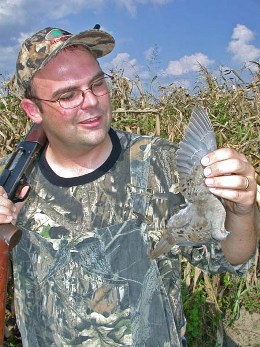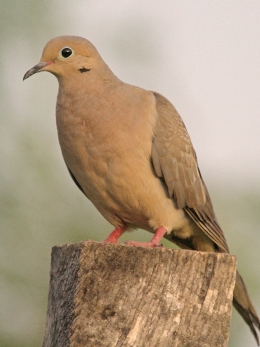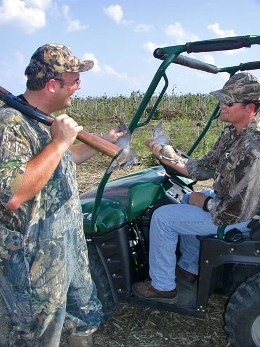John Phillips with Kevin Tate | August 02, 2010
 Hunters are gearing-up for dove season to open in September. These ideas will help you have more success with hunting doves. Kevin Tate has more than 25 years of dove-shooting experience. Tate tells us his top-10 tricks for shooting doves more effectively and consistently this month.
Hunters are gearing-up for dove season to open in September. These ideas will help you have more success with hunting doves. Kevin Tate has more than 25 years of dove-shooting experience. Tate tells us his top-10 tricks for shooting doves more effectively and consistently this month.
Tate says he often sees outdoorsmen who hunt doves wearing their faded blue jeans and college T-shirts. “If the doves happen to be flying fast and furious on the days that they hunt, these non-camouflaged hunters may make a few fatal shots. But if hunters will wear camouflaged clothing instead of street clothes and make an effort to hide, they will significantly improve their odds for taking doves. I prefer to wear Mossy Oak Break-Up or Shadow Grass camouflage when I hunt doves. These two patterns blend well with the surroundings I find myself in when I hunt doves in the South, where you'll find scrub brush and weeds. Too, you often have to shoot over cut cornfields or bean fields. Mossy Oak Break-Up and Shadow Grass will disguise your form and enable you to position yourself for a shot in these regions without the doves spotting you.
You also may consider using a camouflaged or a bush blind when hunting doves. You don't have to build an elaborate blind. However, if you'll back-up in the weeds about 3 to 4 feet and keep your face down as much as possible when the doves approach and until you're ready to stand up and shoot, you'll get more shots in a 35-foot radius. The closer the doves are to you when you shoot, the better your odds are for taking a bird. If you can get the doves to fly to you, you'll improve your chances tenfold, and camouflage will help bring the doves in closer.”
Prepare the Field
 Most people hunt in areas where someone specifically has prepared a field for dove hunting. According to Tate, “Agricultural practices are very conducive to dove hunting. Landowners often cut corn or grain and harvest assorted fields that produce food the doves like to eat to attract doves to their fields. If you grow crops in an area that doves frequent and cut those fields 10 to 14 days before dove-hunting season opens, you greatly can increase the numbers of doves in your region. But be sure to check state laws, and even better, have a conservation officer look at your dove field before you start hunting it.”
Most people hunt in areas where someone specifically has prepared a field for dove hunting. According to Tate, “Agricultural practices are very conducive to dove hunting. Landowners often cut corn or grain and harvest assorted fields that produce food the doves like to eat to attract doves to their fields. If you grow crops in an area that doves frequent and cut those fields 10 to 14 days before dove-hunting season opens, you greatly can increase the numbers of doves in your region. But be sure to check state laws, and even better, have a conservation officer look at your dove field before you start hunting it.”
Choose the Best Gun
You'll need to hunt with a gun that you've practiced with and that's best-suited for you. As Tate mentions, “Some hunters will purchase or borrow guns a week or two before dove season begins. Instead of going to a skeet range and shooting two or three boxes of shells to become accustomed to the guns, they'll save those shells and waste twice that many on opening morning by missing most of the doves they attempt to take. The key to shooting doves is being very familiar with the gun you're using. The 20-, 16- and 12-gauge shotguns are the most-popular and the easiest guns to use. I prefer to shoot a 12-gauge Winchester automatic because of its familiarity. I also like the 12-gauge shotgun because it provides more shots, a better range and a difference in recoil compared to a 20 gauge. Additionally, the 12 gauge gives me more opportunity for success with a little-more shot capacity. I use No. 7 size shot in a Winchester shell. You can expect shot uniformity with a Winchester shell, which leads to better patterns and better-overall performance.”
Select Proper Loads
Tate emphasizes, “I always advise hunters to pattern their shotguns. Get a piece of poster board and half-a-dozen different dove loads, and shoot at the board to see how the loads pattern. You'll be amazed at how various loads perform in the same shotgun. Some loads are inexpensive for a reason. They're not well-made, and the shot may not be uniform. As a result, the load may not pattern well. For example, you may shoot a poster board with a loaded 12 gauge at 30 yards, but there may be holes in the pattern through which you can throw a football. That pattern is not satisfactory for hunting. Too, using inferior equipment is not respectful to the game you're shooting.”
Pre-Season Practice
As hunting season continues, and the doves fly faster and higher, you’ll have reduced opportunities for easy shots. That's why you need to improve your shooting percentages now to take a supper's worth of doves later in the season. “Nothing beats going to your local gun club to shoot a few rounds of skeet to tune-up for dove season,” Tate explains. “Skeet shooting is not only fun – it’s great practice and exercise. Skeet may not fly exactly like doves fly. For instance, a bird doesn't slow-down as it flies, whereas skeet does. However, the fundamentals of skeet shooting are so similar to dove hunting that nothing else comes as close to it as the shooting experience you can get at your local gun club. Too, when you're a beginning shooter, having an experienced hunter with you is beneficial. While you're shooting skeet, the pros can watch you mount and swing your gun and help you correct those mistakes before you hunt doves.”
Don't Give Up
Don’t give up on your dove hunting - even if you haven’t had much success in the early dove season. “Some of the best dove hunts occur late in the season,” Tate reports. “Since doves are migratory birds, the first few shoots of the year only may involve local birds that have not yet migrated. However, as the season progresses, you'll discover large groups of adult birds flying through your area on their way south. You can have some productive dove shoots later in the year, if you keep your field prepared and don't give up on the hunt.”
Learn the Flight Patterns of Doves
 “If you can visit the hunting site a few days before the hunt and watch how the doves fly, you'll often find that they have favorite trees or preferred entrances and exits on the fields,” Tate explains. “Position yourself in one of those flyways to increase your odds for bagging a bird. Study the layout of the field, and choose a stand site near a fence or a tree line on the side of the field. The birds generally will fly low over fields and look for something to eat. When they fly over the fence, the doves will be coming over at a standard height and not be in a rush.”
“If you can visit the hunting site a few days before the hunt and watch how the doves fly, you'll often find that they have favorite trees or preferred entrances and exits on the fields,” Tate explains. “Position yourself in one of those flyways to increase your odds for bagging a bird. Study the layout of the field, and choose a stand site near a fence or a tree line on the side of the field. The birds generally will fly low over fields and look for something to eat. When they fly over the fence, the doves will be coming over at a standard height and not be in a rush.”
Swing Thoughts and Safety
“As you practice and learn how to shoot properly, you'll discover that some shots are easier for you to make than other shots,” Kevin Tate says. “My favorite shot to take is at a dove that's flying toward me. I'll black-out the dove with my gun barrel and shoot at the bird as I swing-through. Generally I'll take doves 18 times out of 20 when the shot is set-up right. But I've shot with hunters who make better wing shots or crossing shots than I do. If you'll take note of how the doves fly on any given field and then set-up your shots accordingly, you can improve your success for bagging birds.”
“Shooting well and taking doves often depends on how long you sit at a hunting site,” Tate reports. “You also must be willing to relocate on the field to get a shot. Often you may go to a shoot - especially on opening-day morning - and it's the first time the hunters have had their guns out since dove season the previous year. You'll probably see a hunter on the field every 30 yards. To be successful, you have to be patient and not waste shells on long shots and spook birds with long shots. You have to wait for your opportunities to come. You don't have to be completely hidden, but you do have to be still because doves will pick up on motion in an instant. Some hunters will see doves coming in their direction and stand up, fidget around and mount their guns. The doves may come-in but flare at 40 yards instead of 30. If you'll be patient and allow the doves to come in 10 more yards, you'll increase your chances of bagging a dove.”
Your shots will come unexpectedly, so thinking about safety each time you go dove hunting is important. Taking a dove isn't worth the risk of an injury. “When you go to the field, be aware of everyone's location before the hunt begins,” Tate emphasizes. “You don't want to be setup too close to someone else, and you want to be conscious of your shots every time. Because doves may fly low over the field, when you aim and shoot at them, you may be pointing your gun straight across the field at a hunter who's camped out on the other side. Don't let your excitement about the hunt override your common sense. Be aware of the gun you're holding in your hands, and point it in a safe direction—never at anything you don't want to shoot. Always be aware of your target and your surroundings, and you'll be safe. Also, wear shooting glasses and ear protection.”



























